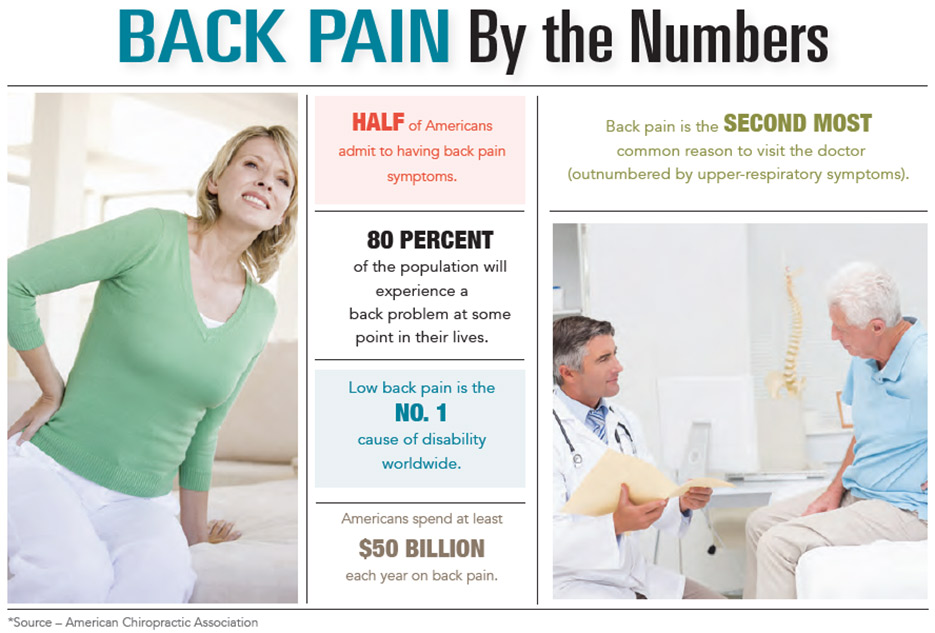More than 80 percent of all Americans will experience low back pain at some point during their lifetime. According to Crow and Willis, the economic impact of low back pain in the United States is estimated at $240 billion annually in terms of treatment costs, lost wages and lost productivity.
Two common classifications of low back pain are radicular and axial.
Radicular pain, commonly referred to as sciatica, typically starts as a result of lifting something heavy or twisting the lower back in a manner that herniates a spinal disc. This herniation results in deep and searing pain that is often accompanied by numbness and weakness. The cause of the pain is a pinched nerve, with pain radiating along the sciatic nerve from the lower spine to the lower back, gluteal muscles, back of the upper thigh, calf and foot. Thankfully, in 90 percent of cases, symptoms subside within six weeks.
Meanwhile, axial pain is another major type of low back pain that occurs as fluid leaks from spinal discs and results in the degeneration of discs. When they are doing their job, spinal discs allow a wide range of movement and serve as shock absorbers between the vertebrae. The leaking fluid causes inflammation, nerve pain, tingling or numbness along the nerve root leading out of the spine.
Neurosurgeon Dr. Sabino D’Agostino suggested that individuals experiencing recurring back pain should sit down with a back specialist to discuss the reasons for their pain. After examining an MRI, a neurosurgeon will be in the best position to determine if the low back pain is being caused by a pinched nerve (radiculopathy) or degenerative disc (axial). The surgeon can then put together a treatment plan that will enhance the patient’s function and quality of life. In some cases, surgery might be the best option, while in other cases nonsurgical interventions might be better.
Below is a brief summary of some of the nonsurgical options available that can be effective in reducing the patient’s pain to a manageable level.
Exercise and Stretching Programs
Individuals experiencing back pain often will benefit from exercise and stretching, similar to what is offered in a six-week program at MUSC to help people deal with occasional to moderate lower back pain. The program is designed to strengthen the superficial and deep core muscles, as well as improve joint range of motion. Non-members are welcome to try the program at the MUSC Wellness Center.
The course is taught by Matthew Blair Davis, who is a muscle and movement specialist and an expert at correcting the causes behind pain and dysfunction.
According to Davis, “Proper diaphragmatic breathing is critical. Many people experiencing back pain fail to use their core muscles because they don’t focus on the smaller details of breathing, posture and hip hinging. We start our classes with at least three to four minutes of breathing techniques that will be used in every exercise throughout the hour.”
Another goal of the program is to improve a person’s ability to move pain-free, to leave the class with increased range of motion in the ankles, hips, upper spine, shoulders and neck. Participating in the program can help reduce pain and the likelihood of back injury by improving breathing, posture, flexibility and core strength.
Losing weight is another way to reduce wear and tear on joints.
Epidurals
Epidural steroid injections are considered to be one of the best tools for the non-surgical management of sciatica and low back pain. The goal of the injections is to provide temporary relief of pain. Epidurals often are used as part of a comprehensive rehabilitation program that also includes a rehabilitative exercise and stretching program. Individuals can receive up to three epidural steroid injections in a year. Epidurals, however, are less helpful for degenerative discs or annular tears.
Cryotherapy
Individuals experiencing back pain may wish to consider whole body cryotherapy treatments. According to Dr. Marguerite Germain of Germain Dermatology, “Many of my patients have experienced relief of their back pain from exposing the body to ultra-low temperatures of -190 to -260 degrees Fahrenheit for one to three minutes. These treatments have been effective at decreasing and even eliminating back pain. Maintenance sessions are recommended as well.”
Stem Cell Injections
Stem cells have been called the body’s own repair kit because they can change into and potentially heal different kinds of tissue. The stem cells are most commonly harvested from bone marrow at the back of the hip and re-injected at the site of the pain. The newly injected stem cells can repair and regenerate the damaged region and reduce pain and inflammation associated with the condition. At this early stage of research, however, this treatment tends to be an expensive option that does not offer guarantees and is not typically covered by insurance.
Other Options
Dr. D’Agostino also suggested acupuncture, chiropractic, massage and meditation as alternative pain management options that patients might try if out-of-pocket expenses are limited.
According to Dr. D’Agostino, “While surgery should generally be considered a last resort, there are some cases where a surgical solution can be both highly successful and minimally invasive. This would depend on the nature of the problem and the resulting symptoms. However, more often than not, non-surgical solutions should be sought and can be equally successful in resolving the problem. Ultimately, the path chosen should be one mutually understood and agreed upon by the treating physician and the patient.”
If you are experiencing recurring back pain, it would be a good idea to visit a back specialist to develop a plan of action to reduce or eliminate the pain so that you are able to get “back” in the game of life.
By Rich O’Brien








